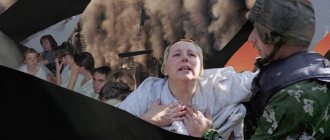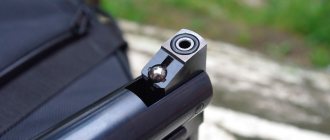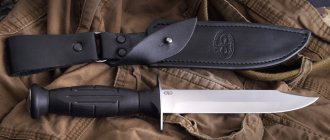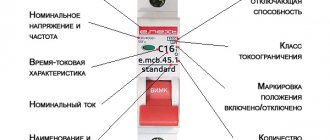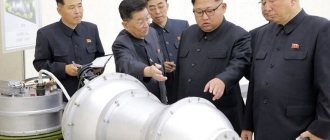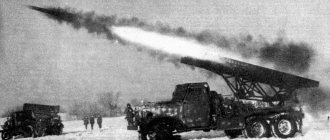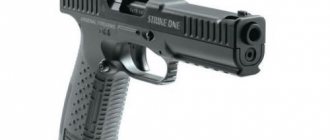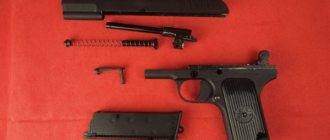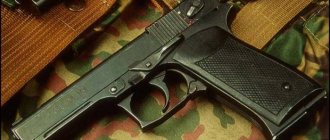The main pistol of the American army
Second place in the Top 5 pistols intended for poor shooters, according to experts from the American weapons portal gunsamerica.com, is occupied by the SIG Sauer P320 pistol. This is a well-built, ergonomic pistol. Convenient sights and a soft trigger allow even beginners and inexperienced shooters to shoot accurately and quickly. The average price of a model on the American market is $600. SIG Sauer P320 The SIG Sauer P320 pistol was first presented at an exhibition in Paris in the summer of 2014. This is a fairly new model of short-barreled weapon. This pistol is designed and manufactured by the American division of the Swiss-German group SIG-Sauer. At the same time, the pistol was designed in close cooperation with the American military and police; their wishes were taken into account by the creators of the pistol. Today, the production facilities of the SIG-Sauer company, which any person interested in weapons has heard of at least once, are located both in Europe and in the USA. Weapons from this manufacturer are widely used by military and law enforcement agencies in many countries around the world. For example, in the USA, every third police officer is armed with a SIG-Sauer pistol, and this ratio is only increasing. Also, pistols from the Swiss-German company are very popular in the civilian firearms market. Today, the SIG Sauer P320 modular pistol is available in 4 modifications of different sizes, each of which additionally has 3 pistol grip size options (large, medium and small). Although SIG-Sauer was inspired by the success of the previous model and the rich experience of its production - we are talking about the P250 pistol model - the P320 pistol became one of a kind, complementing the wide range of weapons produced by the company. At the same time, it became the company's first hammerless pistol. Currently, this pistol is the company's flagship. According to representatives of the SIG-Sauer company, in the USA they are very actively (and quite successfully) working with police departments, seeking to replace Glock pistols with SIG Sauer P320 pistols.
The SIG Sauer P320 pistol uses traditional Browning automatics with a movable barrel and locking by tilting the barrel in a vertical plane. The automatic operation of the pistol works according to the scheme of using recoil with a short barrel stroke. Locking is carried out using the descending breech of the pistol barrel, which enters with its rectangular protrusion located above the chamber into the window intended for ejecting spent cartridges of the bolt-casing. Separately, it should be noted that the pistol is hammerless. The pistol trigger (for those who are not familiar enough with the characteristics of firearms, it is necessary to clarify that the trigger and hammer are two different things) can be changed to other options that are more convenient for the shooter. One of the trigger options used in the pistol is the Glock safety version. Depending on the version of the pistol, in order to fire a shot you need to apply a force corresponding to 2.5-3.4 kg. The frame of the SIG Sauer P320 pistol is composite, it includes two main parts. The first part of the frame is a body made of high-strength polymer with a trigger guard and handle. The second part is the frame, which is made of stainless steel and combines the firing mechanism (trigger mechanism), the bolt stop and the bolt-casing guides. This frame is technically the SIG Sauer P320 frame. It is on this that the serial number of the pistol is applied. The polymer base is made with handles of various lengths, which allows the shooter to easily adapt the weapon to his needs, regarding the characteristics of carrying the weapon and the size of his hands. For example, a mid-size pistol can be quickly and easily converted into a compact version. The barrel and bolt casing of the pistol can also be quickly changed in caliber and size. In the front part of the frame there are grooves for installing Picatinny rails, which are intended for installing a laser target designator or tactical flashlight.
The designers equipped the pistol with a system that protects against accidental shooting. The SIG Sauer P320 was designed with a fire interlock system that prevents the pistol from firing when the bolt is unlocked. Also, the P320 model has a completely symmetrical implementation of control elements. The shooter can reset the magazine using both the right and left buttons. For firing at night, the pistol can be additionally equipped with a special SIGLITE optical system, which is adjustable in the vertical plane. One of the nuances that will definitely appeal to gun owners who are techies at heart is the disassembly and replacement of pistol parts without the use of any tricky devices. The SIG Sauer P320 is quite easy to disassemble, you just need to follow the correct procedure. The first is to remove the magazine, the second is to lock the bolt housing and remove the disassembly lever. After this, the weapon owner can begin to change the components of the pistol. Unlike other polymer-framed models, the P320 hammerless pistol does not require the trigger to be pulled for further disassembly. For the full-size version of the SIG Sauer P320, a 14-round magazine is suitable, we are talking about a magazine chambered for .40 Smith & Wesson cartridges (10x22 mm). In addition, it is possible to use the pistol’s “native” caliber .357 SIG (9x22 mm, created in 1994). But one of the most popular is the 17-round magazine chambered for 9x19 mm Parabellum caliber cartridges. At the same time, for those who choose compact pistol options, the developers offer a choice of smaller magazines with 13 or 15 rounds.
All pistol controls have rounded edges. The SIG Sauer P320 can be optionally equipped with a cartridge presence indicator in the chamber. The trigger guard of the pistol was made with a front protrusion and a notch, with the exception of the Subcompact version. The pistol is available on the market with either a front sight and rear sight with white dots, or with Siglite Night Sights, which are distinguished by the presence of luminous contrast tritium dots. The latest version of the sighting devices allows the shooter to aim the pistol at the target much more accurately and quickly in low light conditions. The overall ergonomics of the pistol are considered quite good by experts. Despite the almost right angle of the handle in relation to the longitudinal axis of the barrel, the pistol fits quite comfortably in the hand and the grip is comfortable. A comfortable grip is also facilitated by the anatomical notch on the handle in the area of the trigger guard and the handle safety stop. At the same time, anti-slip embossing was made on the handle. The front of the trigger guard is also knurled for shooters who use a grip with the finger of their secondary hand placed on the trigger guard. The placement of the trigger closer to the handle of the weapon and the size of the trigger guard allow you to fire even with gloves on. Separately, one can highlight the relatively high profile of the bolt casing, but this is compensated by successful overall ergonomics (and the training carried out by the shooter). In this case, the number of protruding elements located on the side parts of the gun is minimal. Therefore, the SIG Sauer P320 pistol has fairly flat side edges, which, in turn, minimizes the likelihood of the weapon catching on the shooter’s clothing or equipment when removing or using it. Performance characteristics of Sig Sauer P320 (full-size version): Caliber - 9 mm. Length - 203 mm. Barrel length - 119 mm. Height - 140 mm. Width - 35.5 mm. Weight without magazine - 833 g. Magazine capacity - 17 rounds. Sources of information: https://army-news.ru/2014/07/beskurkovyj-pistolet-sig-sauer-p320 https://www.armoury-online.ru/articles/pistols/germany/P320 https://world .guns.ru/handguns/hg/switch/p320-r.html https://warspot.ru/4127-luchshie-pistolety-dlya-plohih-strelkov
(my personal point of view. Without imposing on anyone - there are poles in the Beretta, there are advantages in the Glock, Zik - I haven’t been there, I can’t judge..)
Options
The M1917 revolver was produced by two companies, Colt (based on the Colt New Service
(also known as
the Colt M1909
) chambered in .45 Long Colt) and Smith & Wesson (based on the
Second Model .44 Hand Ejector
)[7].
Smith & Wesson M1917
US Service
The M-1917 .45 Hand Ejector US Service (M1917) was a six-shot solid frame revolver produced by S&W from 1917 to 1946.
After entering World War I, the US Army needed a weapon chambered for the .45 caliber wafer cartridge, so S&W modified its standard weapon to do so. It was based on the basic design of a modified .44 Hand Ejector Second Model
. It was adapted for the .45 ACP cartridge, had a shortened barrel and a modified drum design: it was shortened so that semicircular clips could be inserted and the bottom of the cartridges could be hidden[8].
Smith & Wesson M1917 with special clips ( moon clips |
Compared to Colt, Smith & Wesson left a small recess in the model of its weapon when processing the drum chambers, thanks to which .45 ACP cartridges could be inserted without special clips, but then there were difficulties in removing spent cartridges. The M-1917 model was produced by order of the US Army until 1918[9], the total number of revolvers delivered was 163,476 pieces. Some revolvers went on commercial sale as service and civilian weapons after the end of the war[10]. The S&W company produced about 210,320 revolvers in total.
Colt M1917
Model 1917 (Colt) (eng. Model 1917) - modification of the six-shooter New Service Model
chambered for the .45 ACP wafer cartridge, which began production in 1917 to supply the US Army due to a shortage of the Colt M1911 self-loading pistol[8]. In this model, just like the S&W M1917 revolver, the cylinder was shortened, since the .43 Colt cartridge was longer than the .45 ACP. In order to place cartridges in the drum and ensure quick removal of spent cartridges, plate holder clips in the shape of two crescents (English moonclips) were also used here, 3 cartridges were inserted into each of them. These clips ensured the correct location of the cartridges in the chambers of the drum and the necessary support for the ejector rod when pushing out the cartridges. In total, approximately 150,000 revolvers were produced for the US Armed Forces[11]. In the 1960s, remnants of the M1917 sold for as little as $29.95. Most of those who bought these revolvers modified them. As a result, the small portion of revolvers that have not been modified and remain in good condition are now worth more than S&W's new N-frame revolvers.
Barack Obama issued a corresponding decree to protect citizens from excessive use of force
Yesterday, US authorities issued an order prohibiting police from using most types of military equipment and weapons, including armored personnel carriers, grenade launchers and UAVs. The use of some other types of equipment will be limited. Discussions about the need to demilitarize the police come after a series of mass protests erupted last year over police killings of unarmed people suspected of committing crimes.
Yesterday, US President Barack Obama announced a ban on the use of most types of military equipment and weapons by police. Police will now be prohibited from using armored personnel carriers, grenade launchers, unmanned aerial vehicles (UAVs), bayonets, 50-caliber or higher ammunition and certain types of camouflage. Federal authorities will be completely prohibited from transferring these types of weapons and equipment to police departments. The authorities also want to develop a list of weapons that will be provided to police only after additional certification and guarantees of their responsible use. This will include, for example, explosives and special equipment to suppress mass protests. The ban takes effect immediately, while restrictions are still being discussed.
How Baltimore was engulfed in riots
The militarization of police and their increased use of military equipment began after the September 11, 2001, terrorist attacks. However, recently more and more questions have begun to arise about the advisability of owning and using military weapons by police officers. Last August, the police killing of black man Michael Brown sparked thousands of protests in the American city of Ferguson. The performances continued for several weeks, and about 50 participants were detained. Residents of 90 US cities, including Washington and New York, attended rallies of solidarity with the population of Ferguson. Following the policeman's acquittal in November, a new wave of unrest broke out in Ferguson, during which 25 houses were set on fire and looted in just one night (from November 25 to 26). Similar riots took place in August in the American city of St. Louis, where police killed a black youth suspected of robbing a store. Last December, protests against police officers began in New York, Brooklyn, Chicago and other cities. The reason was the murder of African-American Akai Gurley by a law enforcement officer in New York. According to investigators, the policeman accidentally discharged his weapon.
When the people of the USA threatened the police
As Barack Obama said yesterday: “We've seen how the use of military equipment has left people feeling like they are an occupying force that is confronting a community instead of protecting it. Some weapons are designed for the battlefield and are not suitable for police use.” But not everyone agrees with the need for such measures. According to James Pascoe, the largest police association in the United States, the Fraternal Order of Police, the problem is overestimated: “Most of the weapons and equipment that the police borrow from the army are protective and intended for administrative purposes.”
Yana Rozhdestvenskaya
How they decided to deprive the police of military supplies
The program, which has been in place in the United States since 1997, provides police officers with the Pentagon's surplus military arsenal - the latest military rifles, light machine guns and grenade launchers, as well as armored vehicles, all-terrain vehicles and armored personnel carriers. Over the past year alone, as part of this program, the US military department has transferred weapons worth almost $450 million to the police. Read more
